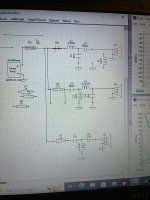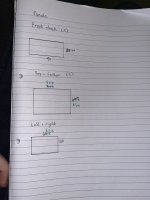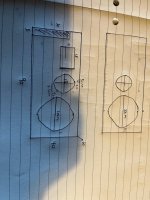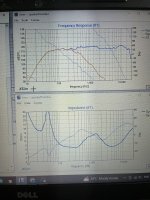Hi all, long time lurker and first time poster.
I’m designing a 3 way speaker, using all faitalpro 12fe300, M5N8-80, and hf100 with sth100 horn.
As this is my first diy, I’d like some opinions and to see if it’d work before I pull the trigger and buy all the parts.
I’ve ripped the frequency responses and impedance graphs off the faitalpro website. Using fpgraph tracer I made my own zma and frd files, and used xsim’s predicted phase.
The 5” m5n8 will have a small box around it made of the same 18mm mdf that the rest of the box will be made out of. Port is 30cm by 5cm by 3.9cm deep tuned to 50hz In a roughly 220L box.
Pictures attached are frequency response on xsim , impedance, and dimensions.
I’ll be attaching a 4ohm resistor before the amp when plugging into an 8-16ohm300w amp before I get a 2-8ohm tpa3255amp(where I will stop using the 4ohm resistor, I’ll get a high wattage resistor). Will I blow anything up? Lol
Thanks in advance, all help will be appreciated.
I’m designing a 3 way speaker, using all faitalpro 12fe300, M5N8-80, and hf100 with sth100 horn.
As this is my first diy, I’d like some opinions and to see if it’d work before I pull the trigger and buy all the parts.
I’ve ripped the frequency responses and impedance graphs off the faitalpro website. Using fpgraph tracer I made my own zma and frd files, and used xsim’s predicted phase.
The 5” m5n8 will have a small box around it made of the same 18mm mdf that the rest of the box will be made out of. Port is 30cm by 5cm by 3.9cm deep tuned to 50hz In a roughly 220L box.
Pictures attached are frequency response on xsim , impedance, and dimensions.
I’ll be attaching a 4ohm resistor before the amp when plugging into an 8-16ohm300w amp before I get a 2-8ohm tpa3255amp(where I will stop using the 4ohm resistor, I’ll get a high wattage resistor). Will I blow anything up? Lol
Thanks in advance, all help will be appreciated.
Attachments
The 390uF cap will probably mess up your bass response if you use a ported enclosure.
The manufacturer's response and impedance graphs are usually measured in an infinite baffle.
Also, did you consider baffle step and other diffraction effects?
As i wrote to other first-timers starting with a three-way - why don't you practice your skills with a smaller 2way?
Chances of frustrating failure are much smaller with a small project!
The manufacturer's response and impedance graphs are usually measured in an infinite baffle.
Also, did you consider baffle step and other diffraction effects?
As i wrote to other first-timers starting with a three-way - why don't you practice your skills with a smaller 2way?
Chances of frustrating failure are much smaller with a small project!
Thanks for the response,
I thought adding the capacitor would protect my woofers from over extending at high wattage but I’m not sure if I just need to eq it or not, (as it goes over xmax below 50hz at 300w on winISD). I was using it was a ~50hz hpf.
I haven’t considered baffle step. I also have an equaliser I could plug in before the amp, could placing it in the corner of a room mean mean no need for BSC?
Thanks in advance🙂
I thought adding the capacitor would protect my woofers from over extending at high wattage but I’m not sure if I just need to eq it or not, (as it goes over xmax below 50hz at 300w on winISD). I was using it was a ~50hz hpf.
I haven’t considered baffle step. I also have an equaliser I could plug in before the amp, could placing it in the corner of a room mean mean no need for BSC?
Thanks in advance🙂
Placing it in the corner requries designing it to be there otherwise the midrange will, to put it simply, kick in and out of baffle step in a troublesome way.
Perhaps you could just reduce your upper response in the usual way. You can do this visually for now, it will be better than nothing.
Perhaps you could just reduce your upper response in the usual way. You can do this visually for now, it will be better than nothing.
I made a quick simulation with hornresp, just to be sure I am not writing BS.The 390uF cap will probably mess up your bass response
here is what the cap will do (red) to your woofer's response (grey):
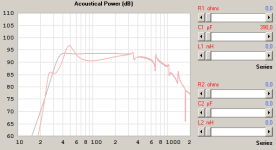
that is a terrible idea - it will again mess up your response and it will get VERY hot!attaching a 4ohm resistor before the amp when plugging into an 8-16ohm300w amp
furthermore you do not need to do that. as far as i see the impedance just goes down to 6 ohms which IMO is within the tolerance for an 8 ohm speaker.
placing your speaker against the back wall will compensate most baffle step effect (your back wall is the infinite baffle, so to say).could placing it in the corner of a room mean mean no need for BSC?
there will be some midrange comb filtering effects, depending on the distance between baffle and back wall and on the baffle size.
best would be having very little distance to back wall or even mounting speakers flush into the wall.
for simulating baffle and room interaction effects have a look at this simulator:
http://audio.claub.net/software/jbabgy/BDBS.html
I would not put the speakers in the corners.
that can be quite a challenge and it's not a project that can be simply simulated to perfection and built (no loudspeaker can, of course!).
just do a search for threads about this topic.
400 - 2k needs to come down 3 dB which is basically your total midrange output. Otherwise it will be very fatiguing to listen with most music. The 10k treble bump needs to at least be dropped 2dB if it needs to sound palatable and accurate in an acoustically live and hot room.
The bass will be disappointing with that big C7 cap in there.
The bass will be disappointing with that big C7 cap in there.
